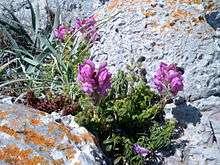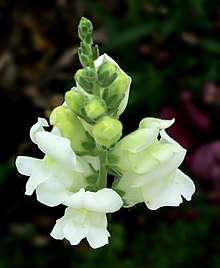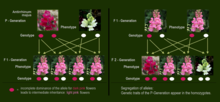Antirrhinum majus
Antirrhinum majus, the common snapdragon (often - especially in horticulture - simply "snapdragon"), is a species of flowering plant belonging to the genus Antirrhinum. The plant was placed in the family Plantaginaceae following a revision of its prior classical family, Scrophulariaceae.[2][3]
| Antirrhinum majus | |
|---|---|
| Plant growing in an old wall in Thasos, Greece | |
| Scientific classification | |
| Kingdom: | |
| (unranked): | |
| (unranked): | |
| (unranked): | |
| Order: | |
| Family: | |
| Genus: | |
| Species: | A. majus |
| Binomial name | |
| Antirrhinum majus | |
The common name "snapdragon", originates from the flowers' reaction to having their throats squeezed, which causes the "mouth" of the flower to snap open like a dragon's mouth. It is widely used as an ornamental plant in borders and as a cut flower. It is perennial but usually cultivated as an annual plant. The species has been in culture since the 15th century.[4]
Taxonomy


There are five subspecies:[5][3]
- Antirrhinum majus subsp. majus. Southern France, northeast Spain.
- Antirrhinum majus subsp. cirrhigerum (Ficalho) Franco. Southern Portugal, southwest Spain.
- Antirrhinum majus subsp. linkianum (Boiss. & Reut.) Rothm. Western Portugal (endemic).
- Antirrhinum majus subsp. litigiosum (Pau) Rothm. Southeastern Spain.
- Antirrhinum majus subsp. tortuosum (Bosc) Rouy. Throughout the species' range.
Description

It is an herbaceous perennial plant, growing to 0.5–1 m tall, rarely up to 2 m. The leaves are spirally arranged, broadly lanceolate, 1–7 cm long and 2-2.5 cm broad. The upper glandular stalk is stalk-round, sometimes woody to the middle. The opposite leaves are simple, elliptic or ovate to broad-lanceolate, sometimes linear and usually bleak. Leaflets are missing.[7]
The flowers are produced on a tall spike, each flower is 3.5-4.5 cm long, zygomorphic, with two 'lips' closing the corolla tube lobed divided into three parts and is purple red, almost 5 cm long. Wild plants have pink to purple flowers, often with yellow lips. Most 8 to 30 short stalked flowers are in an inflorescence together; the inflorescence axis is glandular hairy. The crown is 25 to 45 (rarely to 70) millimeters long and in different colors (red, pink, orange, yellow, white). The "maw" of the crown is closed by protuberance of the lower lip, one speaks here of "masked", and everted baggy at the bottom. There is a circle with four stamens. The plants are pollinated by bumblebees, and the flowers close over the insects when they enter and deposit pollen on their bodies. Calyx is up to 8 mm long, with sepals of equal length, oblong to broad.
The ovary is supreme. The fruit Is an ovoid capsule 10–14 mm diameter shaped like a skull,[8] containing numerous small seeds. [9]
Range
It is native to the Mediterranean region, from Morocco and Portugal north to southern France, and east to Turkey and Syria. They often grow in crevices and walls.[5]
Cultivation

Antirrhinum majus to some extent can survive frost as well as higher temperature, but does best at temperatures around 17–25 °C. Nighttime temperatures around 15–17 °C encourage growth in both the apical meristem and stem of A. majus.[2] The species is able to grow well from seeds, flowering quickly in 3 to 4 months. It is also able to be grown through cutting.[10]
Though perennial, the species is often cultivated as a biennial or annual plant, particularly in colder areas where it may not survive the winter. Numerous cultivars are available, including plants with lavender, orange, pink, yellow, or white flowers, and also plants with peloric flowers, where the normal flowering spike is topped with a single large, symmetrical flower.[9][11] The cultivars ’Floral Showers Deep Bronze’[12] and ‘Montego Pink’[13] have gained the Royal Horticultural Society’s Award of Garden Merit.
The trailing (creeping) variety is often referred to as A. majus pendula (syn. A. pendula, A. repens).
It often escapes from cultivation, and naturalised populations occur widely in Europe north of the native range,[9] and elsewhere in temperate regions of the world.[3]
Model research organism
In the laboratory it is a model organism,[14] for example containing the gene DEFICIENS which provides the letter "D" in the acronym MADS-box for a family of genes which are important in plant development. Antirrhinum majus has been used as a model organism in biochemical and developmental genetics for nearly a century. Many of the characteristics of A. majus made it desirable as a model organism; these include its diploid inheritance, ease of cultivation (having a relatively short generation time of around 4 months), its ease of both self-pollination and cross-pollination, and A. majus's variation in morphology and flowering color. It also benefits from its divergence from Arabidopsis thaliana, with A. thaliana's use as a common eudicot model, it has been used to compare against A. majus in developmental studies.[2]
Studies in A. majus have also been used to suggest that, at high temperatures, DNA methylation is not vital in suppressing the Tam3 transposon. Previously, it was suggested that DNA methylation was important in this process, this theory coming from comparisons of the degrees of methylation when transposition is active and inactive. However, A. majus's Tam3 transposon process did not completely support this. Its permission of transposition at 15 °C and strong suppression of transposition at temperatures around 25 °C showed that suppression of the transposition state was unlikely to be caused by the methylation state.[15] It was shown that low temperature-dependent transposition was the cause of the methylation/demethylation of Tam3, not the other way around as previously believed. It was shown in a study that decreases in the methylation of Tam3 were found in tissue that was still developing at cooler temperatures, but not in tissue that was developed or grown in hotter temperatures.[16]
Antirrhinum majus has also been used to examine the relationship between pollinators and plants. With debate as to the evolutionary advantages the conical-papillate shape of flower petals, with arguments suggesting the shape either enhanced and intensified the color of the flower or aided in orienting pollinators through sight or touch. The benefit that A. majus brought was through an identification of a mutation at the MIXTA locus that prevented this conical petal shape from forming. This allowed testing of the pollination plants with and without conical petals as well as comparisons of the absorption of light between these two groups. With the MIXTA gene being necessary in the formation of conical cells, the use of the gene in breeding of Antirrhinum was crucial, and allowed for the tests which showed why many plants produced conical-papillate epidermal cells.[17]
Another role A. majus played in examining the relationship between pollinator and plant were in the studies of floral scents. Two of A. majus's enzymes, phenylpropanoids and isoprenoids, were used in the study of its floral scent production and the scent's effect on attracting pollinators.[2]
Chemistry
Antirrhinin is an anthocyanin found in A. majus.[18] It is the 3-rutinoside of cyanidin. Its active ingredients include mucilages, gallic acid, resins, pectin and bitters. It is a topical emollient, antiphlogistic, astringent, antiscorbutic, hepatic and diuretic. It is effective against inflammations, it is used for haemorrhoids. It has been used in gargles against ulcerations of the oral cavity. Internally, it can be used for colitis and heartburn. Externally, as poultices, on erythemas.
Pests and diseases
Antirrhinum majus may suffer from some pests and diseases.
Pests
Insects are the primary pests that affect A. majus.
- Aphids: They target and consume the terminal growth and underside of leaves. Aphids consume the liquids in the plant and may cause a darkened or spotted appearance on the leaves.[19]
- Frankliniella occidentalis: These insects affect even strong growing and healthy Antirrhinum; they are commonly seen in newly opened flowers. They will cause small lesions in the shoots and flower buds of A. majus as well as remove pollen from the anther. This case is difficult to treat, but may be kept manageable with the predatory mite Neoseiulus.[2]
Diseases
Antirrhinum majus suffers mostly from fungal infections.
- Anthracnose: A disease caused by fungi of the genus Colletotrichum. This disease targets the leaves and stem causing them a yellow with a brownish border to the infected spot. It is recommended to destroy infected plants and space existing ones farther apart.[19]
- Botrytis: Also known as Grey Mould, this infection occurs under the flower of A. majus. Botrytis causes wilting of the flower's spikes and causes a light browning of the stem below the cluster of flowers.[19] Botrytis causes quick and localized drying and browning in the flower, leaves, and shoots of A. majus. In warmer weather, Botrytis becomes more severe. Treatment of Botrytis involves cutting off the infected stock and clearing the surrounding area of A. majus from any of this debris.
- Pythium: Wilting in the plant may be caused by a Pythium species fungal infection if the plant is receiving adequate water.[2]
- Rust: Another fungal disease that A. majus is susceptible to is rust. It can first be seen on the plant as light-green circles, on the stem or underside of its leaves, that eventually turn brown and form pustules.[2] Rust may cause A. majus to bloom prematurely, sprout smaller flowers, and begin decomposition earlier.[19]
- Stem rot: A fungal infection, it can be seen as a cottony growth on the stem, low, near the soil. If infected, it is suggested the plant be destroyed.[19]
Gallery
 Close Up view of Antirrhinum majus
Close Up view of Antirrhinum majus_05.jpg) White Snapdragon Flower
White Snapdragon Flower_08.jpg) Yellow Snapdragon Flower
Yellow Snapdragon Flower Pink Snapdragon Flower
Pink Snapdragon Flower_01.jpg) White Snapdragon Flower
White Snapdragon Flower_03.jpg) Yellow Snapdragon Flower
Yellow Snapdragon Flower Bunch of Pink Snapdragon Flower
Bunch of Pink Snapdragon Flower Antirrhinum majus Flower
Antirrhinum majus Flower
References
- Tank, David C.; Beardsley, Paul M.; Kelchner, Scot A.; Olmstead, Richard G. (2006). "Review of the systematics of Scrophulariaceae s.l. and their current disposition". Australian Systematic Botany. 19 (4): 289–307. doi:10.1071/SB05009.
- Hudson, Andrew; Critchley, Joanna; Erasmus, Yvette (2008-10-01). "The Genus Antirrhinum (Snapdragon): A Flowering Plant Model for Evolution and Development". Cold Spring Harbor Protocols. 2008 (10): pdb.emo100. doi:10.1101/pdb.emo100. ISSN 1940-3402. PMID 21356683.
- "Antirrhinum majus". Germplasm Resources Information Network (GRIN). Agricultural Research Service (ARS), United States Department of Agriculture (USDA). Retrieved 24 December 2017.
- Siegmund Seybold: Flora of Germany and neighboring countries. A book to identify wild and frequently cultivated vascular plants . Founded by Otto Schmeil , Jost Fitschen . 93. Completely revised and expanded edition. Quelle & Meyer, Wiebelsheim 2006, ISBN 3-494-01413-2
- Flora Europaea: Antirrhinum majus
- Neil A. Campbell, Jane B. Reece: Biologie. Spektrum-Verlag Heidelberg-Berlin 2003, ISBN 3-8274-1352-4, page 302.
- Erich Oberdorfer: Plant sociology excursion flora for Germany and adjacent areas . In collaboration with Angelika Schwabe and Theo Müller. 8th, heavily revised and supplemented edition. Eugen Ulmer, Stuttgart (Hohenheim) 2001, ISBN 3-8001-3131-5 , p. 828 .
- "The Dragon's Skull: The Macabre Appearance of Snapdragon Seed Pods". Kuriositas. 26 January 2019.
- Blamey, M.; Grey-Wilson, C. (1989). Flora of Britain and Northern Europe. ISBN 978-0-340-40170-5.
- David A. Sutton: A revision of the tribe Antirrhineae. Oxford University Press, London / Oxford 1988, ISBN 0-19-858520-9 , p. 90-96.
- Huxley, A, ed. (1992). New RHS Dictionary of Gardening. ISBN 978-0-333-47494-5.
- "RHS Plantfinder - Antirrhinum majus 'Floral Showers Deep Bronze'". Retrieved 12 January 2018.
- "RHS Plantfinder - Antirrhinum majus ' Montego Pink'". Retrieved 13 January 2018.
- Oyama, R. K.; Baum, D. A. (2004). "Phylogenetic relationships of North American Antirrhinum (Veronicaceae)". American Journal of Botany. 91 (6): 918–25. doi:10.3732/ajb.91.6.918. PMID 21653448.
- Hashida, Shin-nosuke; Kishima, Yuji; Mikami, Tetsuo (2005-11-01). "DNA methylation is not necessary for the inactivation of the Tam3 transposon at non-permissive temperature in Antirrhinum" (PDF). Journal of Plant Physiology. 162 (11): 1292–1296. doi:10.1016/j.jplph.2005.03.003. hdl:2115/8374. ISSN 0176-1617. PMID 16323282.
- Hashida, Shin-Nosuke; Uchiyama, Takako; Martin, Cathie; Kishima, Yuji; Sano, Yoshio; Mikami, Tetsuo (2017-04-21). "The Temperature-Dependent Change in Methylation of the Antirrhinum Transposon Tam3 Is Controlled by the Activity of Its Transposase". The Plant Cell. 18 (1): 104–118. doi:10.1105/tpc.105.037655. ISSN 1040-4651. PMC 1323487. PMID 16326924.
- Glover, Beverley J.; Martin, Cathie (1998-06-01). "The role of petal cell shape and pigmentation in pollination success in Antirrhinum majus". Heredity. 80 (6): 778–784. doi:10.1046/j.1365-2540.1998.00345.x. ISSN 0018-067X.
- Scott-Moncrieff, R (1930). "Natural anthocyanin pigments: The magenta flower pigment of Antirrhinum majus". Biochemical Journal. 24 (3): 753–766. doi:10.1042/bj0240753. PMC 1254517. PMID 16744416.
- Gilman, Edward F. (2015-05-18). "Antirrhinum majus Snapdragon". edis.ifas.ufl.edu. Retrieved 2017-04-17.
| Wikimedia Commons has media related to Antirrhinum majus. |
| Wikispecies has information related to Antirrhinum majus |